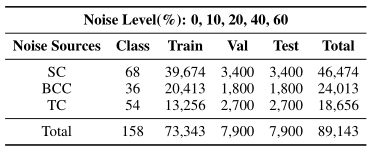a Benchmark for Learning with Real-world Noisy Labels in Natural Language Processing
NoisywikiHow is currently the largest benchmark dataset for noisy label learning in the field of NLP, as of January 2023. It comprises 89K procedural events with heterogeneous and controlled real-world label noise. The dataset was constructed by crawling, filtering and processing data from the wikiHow website up until March 2022.
After meticulous filtering and selection, the dataset contains 158 disjoint classes with a long-tail distribution and a total of 89,143 steps. To simulate real-world scenarios and account for human cognitive patterns and category similarities, we injected noise from multiple sources in proportionate amounts.
This dataset can be used for intent recognition tasks, where the goal is to determine the implied intent given a meaningful step or instruction. Here are some instances:
| procedual event | intent |
|---|---|
| Take presciption weight loss medications. | Losing Weight |
| Check calories on food packaging. | Losing Weight |
| Include cultural and ethnic foods in your plan. | Losing Weight |
| Talk about food differently. | Losing Weight |
-
Data volume during data processing
Stage step intention Collecting 1394307 3334 Normalization and deduplication 1134522 3334 TF-IDF filter 777135 3334 Sample size filter & intention label filtering 89143 158 We have retained two sets of 50 steps each as validation and test sets for each intent.
-
The training set of NoisywikiHow exhibits a long-tail distribution.
-
Overview of NoisywikiHow of multiple noise sources and controlled label noise.
To introduce label noise from open set and Keep the number of target categories unchanged, when injecting label noise into an instance (x,y), we leave the label y unchanged but replace the procedual event x with the one x2 under the category y2, which may not be in the existing 158 classes.
Noise sources:
- SC: sub-categories
- BCC: categories beyond the commonsense
- TC: tail categories
-
Top-1 (Top-5) classification test accuracy (%) of pre-trained language models
Model/Noise Level 0% 10% 20% 40% 60% BERT 60.29(83.53) 58.86(83.32) 57.42(82.57) 52.91(79.84) 48.20(75.37) XLNET 59.77(85.24) 60.23(85.90) 58.25(84.29) 53.74(81.73) 50.23(79.44) RoBERTa 60.59(85.10) 59.65(84.16) 57.77(83.77) 54.18(81.56) 50.85(78.87) GPT2 59.84(85.39) 58.35(84.90) 57.0(83.94) 52.71(80.81) 48.25(78.08) ALBERT 55.13(80.80) 56.21(82.15) 53.68(80.52) 49.93(78.44) 44.81(74.41) T5 58.35(83.63) 56.87(83.03) 56.19(82.20) 52.29(79.94) 47.47(77.39) BART 61.72(86.90) 60.28(85.92) 58.94(84.67) 54.57(82.38) 49.75(78.84) We use BART model as the base model.
-
Effects of Distinct Noise Sources under 10% label noise.
Noise Sources Top-1 Top-5 SCC+BCC+TC (NoisywikiHow) 60.28 85.92 SC 60.14 85.49 BCC 59.65 85.39 TC 57.99 84.37 -
Effectiveness of Different LNL methods
-
Real-world Noise vs. Synthetic Noise
- Some widely accepted LNL methods are not always impactful, especially with real-world label noise.
- Different noise sources may have varying difficulties resisting label noise, although they are all from real-world noise.
- Few LNL methods can effectively combat real-world noise and synthetic noise at the same time.
- The model trained under the real-world label noise has better generalization performance.
To run baseline on NoisywikiHow, you can follow the guide in TORUN.md.
If you find this code useful in your research then please cite:
@inproceedings{wu-etal-2023-noisywikihow,
title = "{N}oisywiki{H}ow: A Benchmark for Learning with Real-world Noisy Labels in Natural Language Processing",
author = "Wu, Tingting and
Ding, Xiao and
Tang, Minji and
Zhang, Hao and
Qin, Bing and
Liu, Ting",
editor = "Rogers, Anna and
Boyd-Graber, Jordan and
Okazaki, Naoaki",
booktitle = "Findings of the Association for Computational Linguistics: ACL 2023",
month = jul,
year = "2023",
address = "Toronto, Canada",
publisher = "Association for Computational Linguistics",
url = "https://aclanthology.org/2023.findings-acl.299",
doi = "10.18653/v1/2023.findings-acl.299",
pages = "4856--4873",
}



